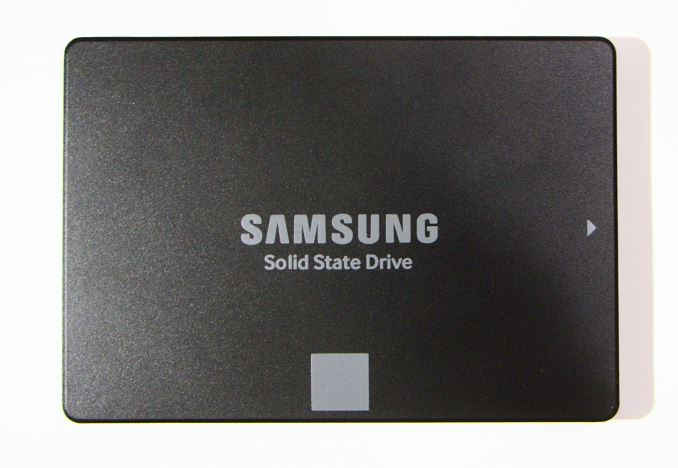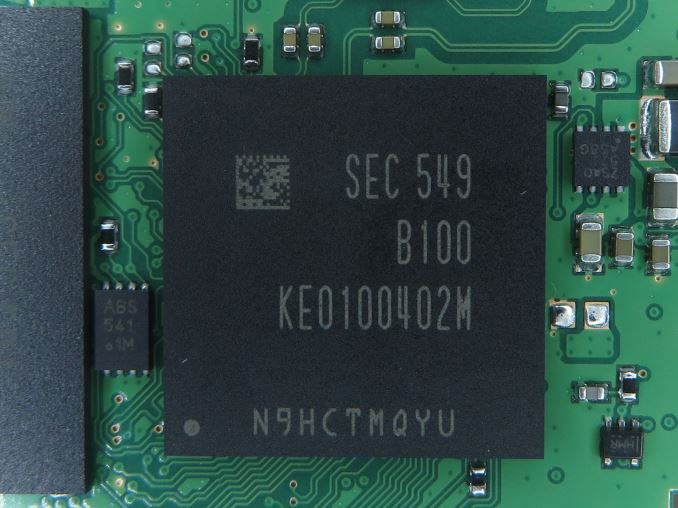The Samsung 750 EVO (120GB & 250GB) SSD Review: A Return To Planar NAND
by Billy Tallis on April 22, 2016 8:00 AM EST
Since the introduction of their first consumer TLC SSD with the SSD 840, Samsung's consumer/retail SATA SSD lineup has consisted of two product families: the MLC-based Pro drives, and the TLC-based 840 and EVO drives. The strength of Samsung's SSD controllers and the advantages of 3D NAND have allowed the 850 EVO to maintain a solidly mid-range position in the SSD market well above any other drive using TLC NAND.
Meanwhile, with the strength of the 850 EVO as a near-midrange product - and with pricing to match - like so many other vendors over the last year, Samsung has also been developing a true low cost TLC drive for the mass market. The end result is the Samsung 750 EVO, which we're revieiwng today. The 750 EVO establishes a new budget-oriented product line that competes in the cutthroat low end of the market where price per GB is the most important aspect of the product.
There are several design choices that help minimize the cost of the 750 EVO, aside from the obvious choice of TLC over MLC. The MGX controller it borrows from the lower capacity 850 EVOs is a dual-core version of Samsung's usual triple-core architecture. Similarly, the 750 EVO is only available in 120GB and 250GB sizes, so there is no high-priced high capacity model. Consequently, with only two small capacities, the 750 EVO line is served by a single tiny PCB layout, made even smaller by the fact that Samsung has put the 256MB of DRAM in the same package as the SSD controller.

Samsung MGX controller with onboard 256MB DRAM
But the most significant aspect of the 750 EVO is that it doesn't use the 3D NAND that has been a key competitive advantage for Samsung's 850 product lines. Samsung has continued development of planar NAND even after transitioning their retail SSDs to 3D NAND, and the 750 EVO in turn uses 16nm planar TLC. It doesn't offer the same performance or endurance of Samsung's 3D NAND, but it does significantly lower the cost of the drive.

128GB of 16nm TLC NAND in a single package
The 16nm TLC NAND is the successor to Samsung's 19nm TLC that had a troubled tenure in the 840 EVO. With the 840 EVO, data at rest on the drive degraded over time and eventually required the use of more thorough and thus slower error correction when read back. As a result the 750 EVO inherits the benefits of all the firmware work Samsung did to mitigate the read speed degradation. This, for what it's worth, gives Samsung some degree of a leg-up against other 16/15nm TLC drives that face the same challenges.
| Samsung TLC SATA SSD Comparison | |||||
| Drive | 750 EVO 120GB | 750 EVO 250GB | 850 EVO 120GB | 850 EVO 250GB | |
| Controller | MGX | MGX | |||
| NAND | Samsung 128Gb 16nm TLC | Samsung 32-layer 128Gbit TLC V-NAND | |||
| DRAM | 256MB | 256MB | 256MB | 512MB | |
| Sequential Read | 540MB/s | 540MB/s | 540MB/s | 540MB/s | |
| Sequential Write | 520MB/s | 520MB/s | 520MB/s | 520MB/s | |
| 4KB Random Read | 94K IOPS | 97K IOPS | 94K IOPS | 97K IOPS | |
| 4KB Random Write | 88K IOPS | 88K IOPS | 88K IOPS | 88K IOPS | |
| 4KB Random Read QD1 | 10K IOPS | 10K IOPS | 10K IOPS | 10K IOPS | |
| 4KB Random Write QD1 | 35K IOPS | 35K IOPS | 40K IOPS | 40K IOPS | |
| DevSleep Power | 6mW | 2mW | |||
| Slumber Power | 50mW | 50mW | |||
| Active Power (Read/Write) | 2.1W / 2.4W (Average) | 2.4W / 2.8W (Average) | Max 3.7W / 4.4W | ||
| Encryption | AES-256, TCG Opal 2.0, IEEE-1667 (eDrive) | AES-256, TCG Opal 2.0, IEEE-1667 (eDrive) | |||
| Endurance | 35TB | 70TB | 75TB | ||
| Warranty | Three years | Five years | |||
By and large the performance specifications for the 750 EVO match the lower capacity 850 EVO, though a slightly lower random write speed at a queue depth of one hints that the 750 EVO may require a bit more background wear leveling work. The feature set is identical to the 850 EVO, making the 750 EVO one of the few low-end drives to support TCG Opal encryption.
Samsung's marketing strategy for the 750 EVO is a little different from their previous retail SSD products. The 750 EVO is targeted specifically at system integrators and system builders, rather than at users looking to upgrade an existing machine. Consequently, they aren't pushing to make the 750 EVO available from as wide a range of retail outlets. Enough of the major online retailers have it in stock that it is not difficult to obtain.
This review will focus on comparing the 750 EVO against Samsung's other SATA SSDs and against other current-generation low-end TLC SSDs of comparable capacity. Our Bench tool can assist in making other comparisons.
| AnandTech 2015 SSD Test System | |
| CPU | Intel Core i7-4770K running at 3.5GHz (Turbo & EIST enabled, C-states disabled) |
| Motherboard | ASUS Z97 Pro (BIOS 2701) |
| Chipset | Intel Z97 |
| Memory | Corsair Vengeance DDR3-1866 2x8GB (9-10-9-27 2T) |
| Graphics | Intel HD Graphics 4600 |
| Desktop Resolution | 1920 x 1200 |
| OS | Windows 8.1 x64 |
- Thanks to Intel for the Core i7-4770K CPU
- Thanks to ASUS for the Z97 Deluxe motherboard
- Thanks to Corsair for the Vengeance 16GB DDR3-1866 DRAM kit, RM750 power supply, Carbide 200R case, and Hydro H60 CPU cooler










109 Comments
View All Comments
Bleakwise - Sunday, April 24, 2016 - link
I apologize for being rude but that's just not what they are made for. Paying 1,000$ for a 2tb NVME SSD just for cold storage is a lot like buying a 500,000$ super-car just to drop your kids off at school....Bleakwise - Sunday, April 24, 2016 - link
More like even up to 8k.A mechanical hard drive will roll out 150-200 GigaBYTES per second sequential read. 4k video is like 5 megaBYTES per second max. 8k would be 20, 16k would be 80. This is on h264, h265 will cut these in half, so you could watch a 32k video on something like a WD black.
I suppose if you wanted to play back something in 64k resolution you'd need an SSD though, at least until CPU/GPU tech makes h266 or h267 codec or whatever available.
Bleakwise - Sunday, April 24, 2016 - link
To be clear. The only reason content creators need NVME drives for 4k is because they work in uncompressed or intermediate formats. They need NVME drives for the same reason that a 4k bitmap is like 22 megabytes while the JPEG is just one or two.Eden-K121D - Sunday, April 24, 2016 - link
I think You meant MegaBYTES otherwise your hypothetical disk would be faster than anything on this planet LOLslowdemon21 - Friday, April 29, 2016 - link
SeaGate barracuda 195 MegaBytes per secBrokenCrayons - Friday, April 22, 2016 - link
Between the OS and software, my Windows desktop is currently using about 110GB of a 250GB hard drive. I don't game much, but there are handful of titles loaded on that system and I haven't exactly been working very hard at keeping my drive clean.On my primary computer (the desktop is more a network appliance than a day-to-day workstation as it runs headless now thanks to a combination of Steam in home streaming and VNC), a laptop with a 60GB SSD, there's about 35GB of free storage capacity, but the OS footprint is a lot smaller since it's a Linux box.
Granted, games are getting larger and a few newer titles I'm likely to play in the next year or so will make it necessary to start looking at more storage, but 250GB seems perfectly reasonable right now.
jabber - Friday, April 22, 2016 - link
Yeah just running 80GB of the 250GB 850EVO in my workstation. Having masses of software and data hanging around on a mchine seem crazy to me. Each to their own. However, most customers I see struggle to go over 60-70GB.bji - Friday, April 22, 2016 - link
This is because you guys don't pirate tons of movies and hoard them on SSD drives like some people who then complain about the cost of the media they use to store their pirated goods. I don't either, which is why the 250 GB SSD in my macbook pro is still only half full after nearly 4 years of use.bji - Friday, April 22, 2016 - link
BTW complaining about the cost of storage for pirated goods is like the ultimate douchebaggery imagineable. Not only are you ripping off people who worked to create the content you've pirated, you want to complain about how much money you have to pay to companies to produce the storage that you need to store it.StrangerGuy - Friday, April 22, 2016 - link
That's not ultimate pirate douchebaggery, it would be complaining why pirated videos are no longer available in Xvid because everybody should cater to people with decade old DVD players.